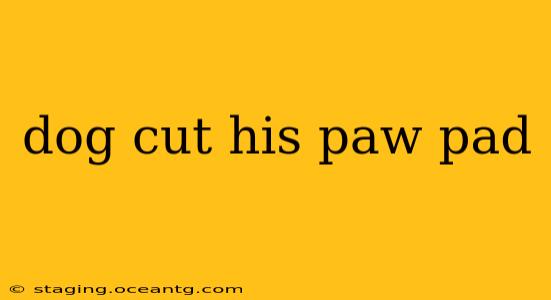It's heartbreaking to see your furry friend limping around, especially when the cause is a painful cut on their paw pad. Dog paw pads are tough, but they can be injured, leading to bleeding, infection, and considerable discomfort for your canine companion. This comprehensive guide will help you understand how to treat a paw pad injury, when to seek veterinary attention, and how to prevent future occurrences.
What Should I Do If My Dog Cuts His Paw Pad?
The first step is to assess the injury. Is it a small nick, a deep gash, or something in between? Minor cuts may require simple home care, while more serious injuries necessitate immediate veterinary attention.
Minor Cuts: For small, superficial cuts, you can start by gently cleaning the wound with a saline solution (you can make your own by dissolving 1/4 teaspoon of salt in one cup of warm water). Avoid using hydrogen peroxide or alcohol, as these can damage the tissue and slow healing. After cleaning, apply a thin layer of antibiotic ointment (check with your vet for recommendations) and cover the wound with a clean bandage. Monitor the paw pad closely for signs of infection (swelling, redness, increased pain, pus).
Deep Cuts or Embedded Objects: If the cut is deep, bleeding profusely, or there's an embedded object, don't attempt to treat it at home. Seek immediate veterinary care. Deep wounds require professional cleaning, stitching, and potentially antibiotics to prevent infection. Embedded objects need to be carefully removed by a veterinarian to minimize further trauma.
How Do I Know If My Dog's Paw Pad Injury Needs a Vet?
Several signs indicate that your dog's paw pad injury needs professional veterinary attention:
- Deep lacerations: Wounds that penetrate deeply into the paw pad require professional care to ensure proper healing and minimize the risk of complications.
- Excessive bleeding: If the bleeding is profuse or doesn't stop after applying pressure for 10-15 minutes, seek immediate veterinary care.
- Signs of infection: Watch for swelling, redness, pus, or a foul odor around the wound. These are all signs of infection, which requires veterinary treatment.
- Lameness or unwillingness to bear weight: If your dog is reluctant to put weight on the injured paw, it suggests significant pain and warrants a vet visit.
- Embedded foreign objects: If something is embedded in the paw pad, such as glass, thorns, or a nail, veterinary removal is necessary.
What Can I Do to Prevent My Dog From Cutting His Paw Pads?
Prevention is always better than cure. Here are some ways to protect your dog's paw pads:
- Regular Paw Pad Checks: Regularly inspect your dog's paw pads for cuts, abrasions, or foreign objects, especially after walks, hikes, or playtime in areas with potential hazards.
- Paw Protection: Use paw protection like booties, especially when walking on hot pavement, rough terrain, or icy surfaces. Gradually introduce your dog to wearing booties to avoid stress and negative experiences.
- Careful Walk Selection: Avoid walking your dog on rough, uneven surfaces, broken glass, or areas with potential hazards like thorns or sharp objects.
- Keep Nails Trimmed: Long nails can make your dog more prone to tripping and injuring their paw pads.
- Winter Protection: In winter, use paw balms to protect your dog's paws from salt, ice, and snow.
My Dog Keeps Licking His Paw Pad – Is That Normal?
Excessive licking can be a sign of pain, irritation, or infection. While some licking is normal, continuous licking can delay healing and even lead to further complications. If your dog is persistently licking his paw pad, it's crucial to examine the area for any signs of injury or infection. If you see anything concerning, consult your veterinarian.
How Long Does It Take For a Dog's Paw Pad to Heal?
Healing time depends on the severity of the injury. Minor cuts may heal within a week or two with proper care. More serious injuries, such as deep lacerations, may take several weeks or even months to fully heal. Regular veterinary check-ups can ensure that the healing process is progressing as expected and that no complications arise.
Should I Put a Bandage on My Dog's Paw Pad?
Bandaging is often recommended for minor cuts to protect the wound, keep it clean, and promote healing. However, for more severe injuries or if your dog is excessively licking or chewing the bandage, your veterinarian might advise against it. Always follow your veterinarian's advice regarding bandaging. It's crucial to ensure the bandage is not too tight and that your dog can still comfortably walk.
By following these guidelines and staying vigilant about your dog's paw health, you can help prevent injuries and ensure your canine companion stays happy and healthy. Remember, if you are ever unsure about the severity of your dog's injury, consult your veterinarian for professional advice.
